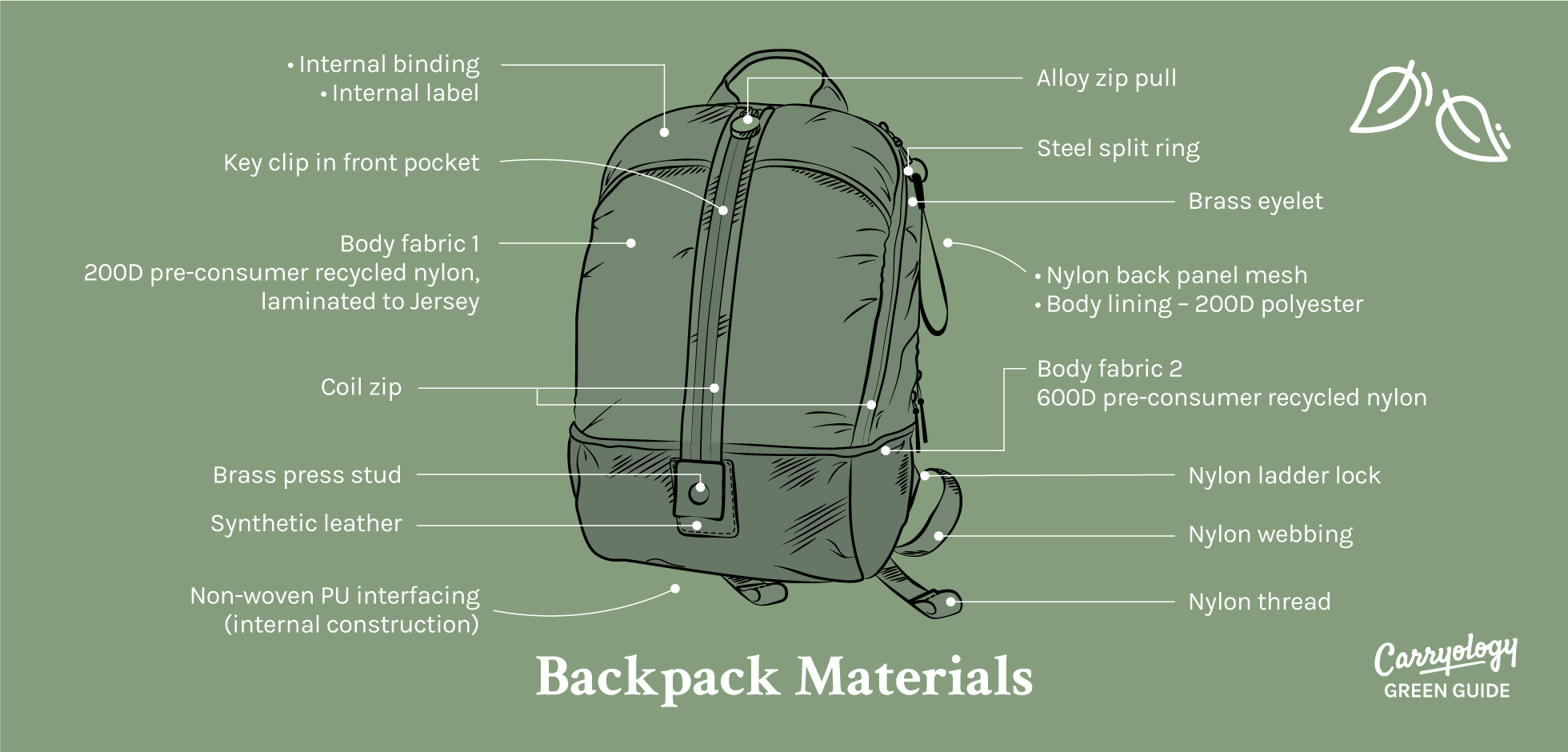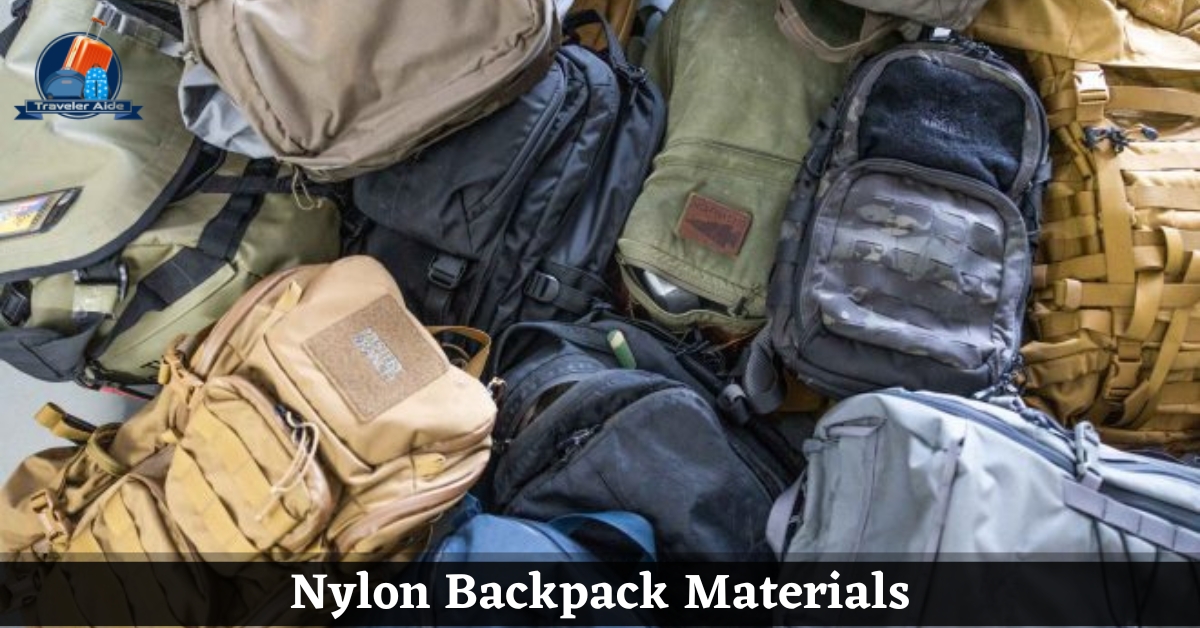Backpacks are made from fabrics like Nylon and Polyester for their strength and low weight, or natural materials like leather and canvas for their durability.

Table of Contents
- The Foundation of Modern Packs: Synthetic Fabrics
- Timeless and Tough: Traditional Natural Materials
- Understanding the Language of Pack Fabrics
- More Than Just Fabric: The Hardware That Holds It Together
- Choosing the Right Material for Your Needs

The Foundation of Modern Packs: Synthetic Fabrics
The vast majority of modern backpacks rely on synthetic fabrics developed in the 20th century. These materials are engineered in a lab to provide specific performance characteristics, offering an impressive balance of strength, low weight, and resistance to the elements. Their consistency and versatility have made them the go-to choice for everything from high-altitude trekking packs to daily school bags. The two dominant players in this category are Nylon and Polyester.

Nylon: The All-Around Champion
Nylon, a type of polyamide polymer, is arguably the most common material used for high-quality backpacks. Its popularity stems from its exceptional strength-to-weight ratio, superior abrasion resistance, and high degree of flexibility. When you need a bag that can withstand scrapes, scuffs, and heavy loads without tearing, nylon is often the best solution. It also has good elasticity, meaning it can stretch under strain and return to its original shape, which helps prevent tearing at the seams.
Not all nylon is created equal. You will often encounter specific brand names or types that indicate different properties:
- Cordura®: This is a well-known brand of air-textured nylon fabric prized for its incredible ruggedness and resistance to abrasion. Often found in high-end hiking, military, and travel packs, Cordura® is built to endure harsh conditions.
- Ripstop Nylon: This fabric is easily identifiable by its unique square grid pattern. Heavier threads are interwoven at regular intervals to create a matrix that stops small tears from spreading into large rips. This makes it a lightweight yet durable option for outdoor and travel bags.
- Ballistic Nylon: Originally developed for anti-fragmentation jackets for airmen in WWII, this is a thick, tough, and heavy nylon with a “basketweave” pattern. It offers exceptional tear and abrasion resistance, making it ideal for luggage and heavy-duty backpacks that see intense use.
Polyester: The Cost-Effective Contender
Polyester, often referred to as Poly, is another synthetic polymer that is widely used in backpack manufacturing. While it is generally less expensive than nylon, it brings its own set of advantages to the table. Polyester’s standout feature is its inherent resistance to ultraviolet (UV) radiation. This means it is less likely to fade or degrade after prolonged sun exposure, making it a great choice for daypacks and school bags used primarily outdoors.
Additionally, polyester absorbs very little water and dries quickly, which helps prevent mildew growth. Although its abrasion and tear resistance are typically lower than a comparable nylon fabric, its lower cost, excellent UV resistance, and vibrant color retention make it a very popular and practical choice for everyday backpacks.
Timeless and Tough: Traditional Natural Materials
Before the advent of synthetic polymers, backpacks were crafted from materials provided by nature. These traditional textiles have stood the test of time, offering unparalleled durability and a classic aesthetic that synthetic fabrics cannot replicate. Their appeal lies in their rugged feel, proven performance, and the way they age gracefully over time.
Canvas: The Classic Workhorse
Canvas is a heavy-duty, plain-woven fabric historically made from cotton or hemp. Its dense weave makes it incredibly durable and resistant to tearing. For centuries, it has been the material of choice for sails, tents, and hardworking bags. While standard canvas can be heavy and absorb water, modern applications often use waxed canvas. By infusing the fabric with wax, manufacturers create a barrier that makes the material highly water-resistant while retaining its classic, rugged appearance.
The main benefits of canvas are its sheer strength and timeless style. However, it is significantly heavier than nylon or polyester and can take a long time to dry if it becomes fully saturated. It remains a popular choice for heritage-style rucksacks, tote bags, and fashion-forward daypacks.
Leather: The Premium Choice for Durability and Style
Leather is one of the oldest and most durable materials known to man. Made from the tanned hide of an animal, it offers a level of toughness, longevity, and sophistication that is difficult to match. A well-made leather backpack is not just a tool for carrying items; it is an investment piece that develops a unique patina—a soft sheen and character that evolves with use—over decades.
The quality of leather varies significantly. Full-grain leather is the highest grade available. It uses the entire grain of the hide, including all the natural imperfections and inherent strength of the outer layer. This makes it incredibly strong and durable. Other types, like top-grain or genuine leather, have been sanded or corrected, slightly reducing their long-term durability. The primary advantages of leather are its professional aesthetic and its ability to last a lifetime with proper care. Its disadvantages include its weight, higher cost, and need for occasional conditioning.
Experience Timeless Craftsmanship with Beldtura
For those who value longevity and unparalleled style, a full-grain leather backpack is the ultimate choice. At Beldtura Leather, we handcraft each bag from the finest full-grain leather, ensuring a product that not only withstands the rigors of daily life but becomes more beautiful with every journey. Our commitment to traditional techniques and quality materials results in a backpack that is both a reliable companion and a statement of enduring quality.
Understanding the Language of Pack Fabrics
When comparing backpacks, you will encounter technical terms that describe the material’s properties. Understanding this terminology is key to deciphering which bag is truly built to last and suit your specific needs. These specifications go beyond the base material to define its thickness, structure, and ability to repel water.
What Is Denier? A Measure of Thread Thickness
Denier, abbreviated as ‘D’, is a unit of measurement for the linear mass density of fibers. In simpler terms, it tells you the thickness of an individual thread or filament used to create the fabric. The measurement is based on a standard: a single strand of silk is 1 Denier. So, a fabric labeled as 600D means that a 9,000-meter strand of its thread weighs 600 grams.
Generally, a higher denier number indicates a thicker, heavier, and more durable thread. A 1000D Cordura pack will be much more rugged than a 210D ripstop pack. However, denier is not the only factor in durability. The type of fiber (nylon is stronger than polyester) and the weave also play a critical role.
Weave and Its Impact on Strength
The way threads are woven together has a massive impact on a fabric’s tear strength and abrasion resistance. A simple plain weave, where threads go over and under in a basic crisscross pattern, is common and effective. However, more complex weaves offer specialized benefits.
As mentioned earlier, a ripstop weave incorporates a thicker reinforcement thread in a grid pattern to stop tears, while a ballistic weave uses a 2×2 basketweave that creates a fabric with immense resistance to abrasion and punctures. The tightness and type of weave contribute just as much to the final strength of the material as the denier of its threads.
Waterproof vs. Water-Resistant: The Role of Coatings
Few backpack fabrics are truly waterproof on their own (leather and waxed canvas being notable exceptions). To protect your gear from rain, manufacturers apply chemical coatings. It is important to distinguish between “water-resistant” and “waterproof.”
- Water-Resistant means the fabric can shed light rain or splashes for a short period. This is often achieved with a DWR (Durable Water Repellent) finish, a topical treatment that causes water to bead up and roll off.
- Waterproof implies the fabric can withstand heavy, sustained rain without letting moisture penetrate. This is usually accomplished with a PU (Polyurethane) coating applied to the inner side of the fabric. Multiple layers of PU coating increase the waterproof rating but can add weight and may degrade over many years.
More Than Just Fabric: The Hardware That Holds It Together
A backpack is only as strong as its weakest link. Even the most durable fabric will fail if paired with subpar zippers, buckles, and straps. Quality hardware is a hallmark of a well-made bag and is essential for its long-term functionality and reliability.
Zippers: The Gateway to Your Gear
Zippers are the most frequently used mechanical part of any backpack. There are two main types: coil zippers, which use plastic or polyester elements, and chain zippers, which have individual metal or molded plastic teeth. Chain zippers are generally stronger and more durable. Reputable brands like YKK® are a sign of quality, as they are globally recognized for their smooth operation and resistance to failure. Some outdoor packs also feature water-resistant zippers with a PU coating or a “garage” flap to keep rain out.
Buckles and Straps
The buckles that secure your straps and compression systems must withstand constant tension and impact. High-quality buckles are typically made from durable plastics like Acetal or from metal alloys. Brands like Duraflex® and Woojin® are industry leaders known for making components that resist cracking in cold weather and do not become brittle over time. The webbing used for straps should also be tightly woven and made from a strong material like nylon to prevent fraying and ensure a secure hold.
Choosing the Right Material for Your Needs
The ideal backpack material depends entirely on how you plan to use it. There is no single “best” fabric—only the most appropriate one for the task at hand. Balancing durability, weight, weather resistance, and aesthetics will help you make an informed decision. Consider what factors are most important for your activities.
Below is a quick reference to help you match common materials to specific uses:
| Use Case | Recommended Material | Key Attributes |
|---|---|---|
| Daily Commute / Office | Full-Grain Leather, Waxed Canvas | Professional look, extreme durability, develops character. |
| Intense Hiking / Backpacking | Cordura® or Ripstop Nylon | High abrasion resistance, excellent strength-to-weight ratio. |
| Light Day Trips / School | Polyester, 400-600D Nylon | Lightweight, cost-effective, good UV resistance, wide color selection. |
| Heavy-Duty Travel / Luggage | Ballistic Nylon, High-Denier Polyester | Maximum tear and abrasion resistance for rough handling. |
By understanding the science behind these materials, you can look beyond the surface appearance of a backpack and assess its true potential for performance and longevity. Whether you prioritize the lightweight engineering of ripstop nylon or the timeless resilience of full-grain leather, choosing the right material ensures your pack will be a reliable partner for years to come.

